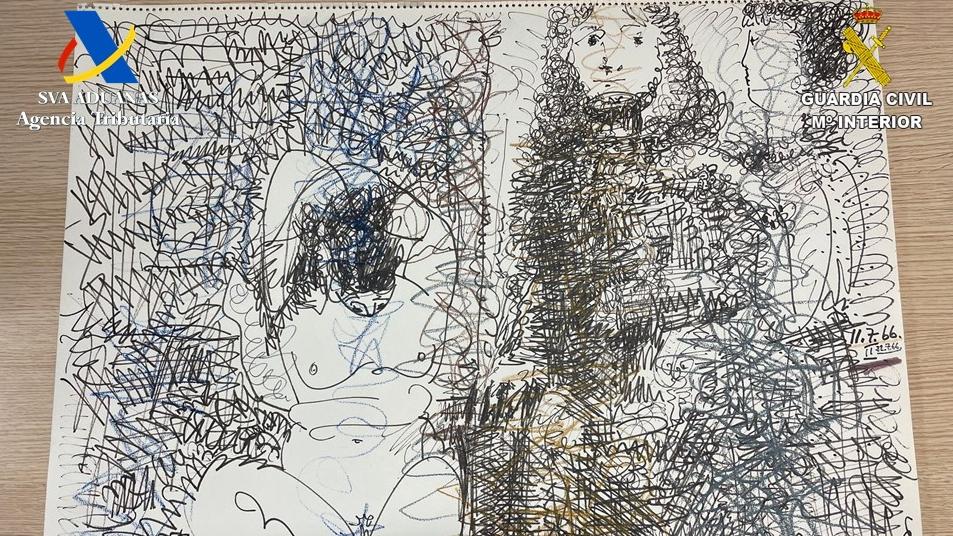 Last week, customs officials on the Spanish island of Ibiza discovered something a bit more exciting than the usual partygoers and tourists – a sketch by Pablo Picasso worth over $463,000. The sketch (Trois Personnages, 1966) was flown into Ibiza from Switzerland. It was found in a passenger’s suitcase after he failed to declare the contraband artwork. He attempted to pass off the original artwork as a print by presenting a falsified receipt listing its value as $1,550. Swiss customs officials noted that the work had been packed in a suspicious manner and alerted their Spanish counterparts. Once the plane arrived in Ibiza, customs officials approached the passenger. After being presented with the false receipt, the agents located another receipt at the bottom of the luggage revealing the supposed print’s true value. The sketch was quickly sent to an art expert, who confirmed its authenticity. The passenger now faces criminal charges of smuggling, failing to declare the value of the artwork, and presenting authorities with a false receipt. The sketch is in the custody of the Ibiza court overseeing the investigation.
Last week, customs officials on the Spanish island of Ibiza discovered something a bit more exciting than the usual partygoers and tourists – a sketch by Pablo Picasso worth over $463,000. The sketch (Trois Personnages, 1966) was flown into Ibiza from Switzerland. It was found in a passenger’s suitcase after he failed to declare the contraband artwork. He attempted to pass off the original artwork as a print by presenting a falsified receipt listing its value as $1,550. Swiss customs officials noted that the work had been packed in a suspicious manner and alerted their Spanish counterparts. Once the plane arrived in Ibiza, customs officials approached the passenger. After being presented with the false receipt, the agents located another receipt at the bottom of the luggage revealing the supposed print’s true value. The sketch was quickly sent to an art expert, who confirmed its authenticity. The passenger now faces criminal charges of smuggling, failing to declare the value of the artwork, and presenting authorities with a false receipt. The sketch is in the custody of the Ibiza court overseeing the investigation.
Yet this is not the first incident involving a smuggled Picasso in Spain. Jaime Botín, former chairman of Spanish bank Bankinter, was sentenced to 18 months in jail and received a $58 million fine (increased to $101 million) in 2020 after attempting to smuggle a painting by Picasso (Head of a Young Woman) out of the country aboard his private yacht. Botín had originally purchased the painting, worth $29 million, in London in 1977. He later planned to sell it at auction, but was unable to remove it from Spain. Christie’s London applied to the Spanish Ministry of Culture for an export permit in 2013 (on Botín’s behalf) but it was denied. The Ministry found that the artwork qualified as a national treasure since it was over 100 years old and the Ministry deemed it culturally significant. The painting is notable for being one of the few exemplars of Picasso’s Rose Period and presents various similarities with the figures in Les Demoiselles d’Avignon, one of the artist’s seminal works and a highlight of the Cubism movement. An art expert deemed the work unique and stated that it is highly unlikely that another painting with these characteristics exists in Spain – or Europe.
Botín was undeterred by the government’s pronouncement as he brazenly took it aboard his yacht, where he sailed to Corsica in 2015. French customs officials boarded the vessel and seized the painting at that time. It was suspected that Botín planned to take the work to Switzerland and sell it there. Botín claims that he was transferring the work abroad for safekeeping, and that he could do so as the legitimate owner of the painting. However, Spain’s patrimony law clearly prohibits the removal of national treasures from Spanish territory without the approval of the Ministry of Culture. The court’s imposition of a substantial fine is indicative of the seriousness with which Spain views attempts to circumvent its cultural heritage export ban; this is the first time a sentence of this magnitude has been imposed in a case involving artwork.
Head of a Young Woman is currently on view at the Reina Sofía Museum in Madrid, where it was transferred for safekeeping in 2015 after its seizure. It will feature in an upcoming exhibition to mark the 50th anniversary of Picasso’s death in 2023. Meanwhile, a court exempted Botín from serving his jail sentence due to illness and advanced age (85), although he ultimately paid the increased fine. He continues to maintain his innocence and stated that he hopes to display the painting at his family’s Centro Botín in Santander one day.
 The problem with smuggled works is not unique to Spain. Just last week, it was reported that a 17th century painting by Artemisia Gentileschi was recovered after it was illegally exported from Italy. The work was recovered and repatriated from Austria to Bari. Two people are being investigated for fraud and illegal export of cultural goods. They disguised the attribution and concealed the historical importance of the work in order to obtain permission to export the painting out of Italy.
The problem with smuggled works is not unique to Spain. Just last week, it was reported that a 17th century painting by Artemisia Gentileschi was recovered after it was illegally exported from Italy. The work was recovered and repatriated from Austria to Bari. Two people are being investigated for fraud and illegal export of cultural goods. They disguised the attribution and concealed the historical importance of the work in order to obtain permission to export the painting out of Italy.